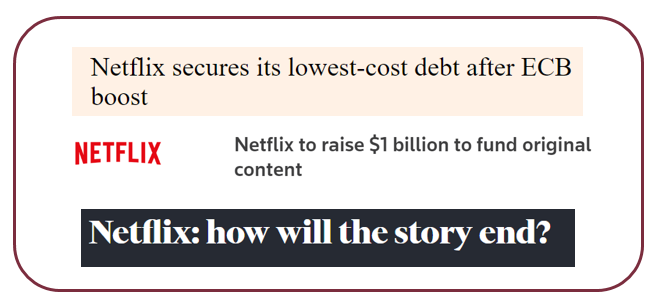Capital Structure – Netflix

The news last week that Netflix is raising another $1bn of debt to fund more original content and possible business acquisitions has again brought into focus Netflix’s funding model and capital structure. In 2019 the company had two separate fundraisings totaling in excess of $ 4bn in debt and as of March they had over $14bn debt on the balance sheet. The current lock-down restrictions across the world due to COVID-19 has increased the demand for these streaming services and taken some of the focus off Netflix’s fast increasing debt pile.
Netflix provide an interesting Investor FAQs page which gives an insight into their capital structure policy. They state their funding preference for content investment is through retained earnings (where available) and to use debt instead of equity…..
“In optimizing our balance sheet, we strive for the capital structure that results in the lowest weighted average cost of capital. Given low interest rates, the tax deductibility of debt and our low debt to enterprise value, financing growth through the debt market is currently more efficient than issuing equity.”

Netflix’s current market capitalisation (i.e. market value of equity) is approx. $187bn (as of today) which suggests a low gearing level based on current debt levels. However pre COVID-19 there were big concerns about the fast increasing debt levels of Netflix to invest in new content. Netflix is a cash burning machine currently (**) and the increasing competitive landscape in the streaming industry means they need to keep ploughing money into content to keep ahead. Their change in business model towards more original content means more capital expenditure required upfront (to fund its development) and the requirement to raise this externally as the company is not generating sufficient retained profits currently.
With the current restrictions there is a big demand for the Netflix’s streaming services but the big question is will it last? Netflix’s significant cash burn every year and rapidly increasing debt pile (coupled with significant content liabilities – both on and off the balance sheet) means they are running fast to keep ahead of their (increasing number of) competitors. The company appears to have a clear debt focused strategy to optimise their capital structure and minimise their overall cost of capital but is that sustainable in the longer term or will the mounting liabilities put the company under too much financial pressure?
So the next time you sit down to binge watch a new series on Netflix you can think about the big financing decisions that lay behind the small screen!
** Nerd Corner
For anyone interested, take a look at Netflix’s accounts in recent quarters/years. The Income Statement looks quite healthy but when you look at the cashflow statement the real picture emerges – significant cash outflows funded through debt. See the FAQ page about how Netflix account for their content purchases and how this can lead to somewhat misleading profit figures. The devil is in the detail in many financial statements!!
Useful Links
Netflix Investor Relations Website
